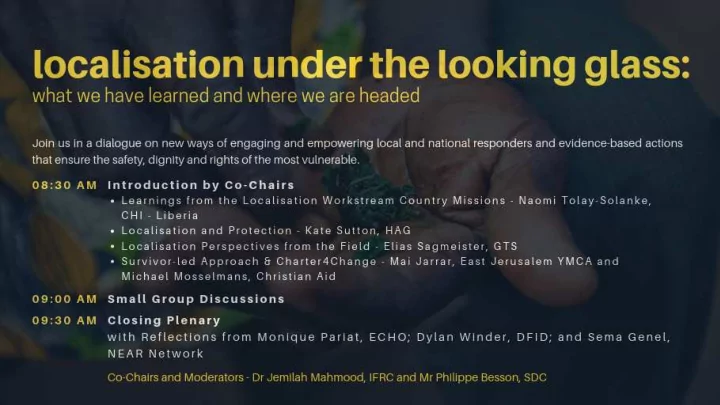

Wha What t we le lear arne ned d from m fie ield ld mis missio ions ns v Localisation is about - striving for complementarity; acknowledging, respecting and supporting local capacities; trust and relationship building v Capacity strengthening should be two-way, long- term and strategic; a risk management strategy v Coordination structures overall are still dominated by international organisations and local organisations struggle to engage v Localisation needs to encompass increased access to participation, decision-making and funding opportunities for women and women’s groups Challenge: What are the perceived and real risks in partnering with local and national actors? How have these been managed and what more can be done?
THE KNOWN - Implementing more locally led responses creates challenges and opportunities for protection. THE NEW - There are important roles for national and international actors but in current responses actors are not recognising and respecting each others roles. International actors often move into national actor space causing friction and undermining established mechanisms THE CHALLENGE - How do we determine the optimal configuration of international and national actors to take on protection roles in locally-led responses? How would this look different to what currently happens?
Em Emerging lessons about loc localiz alization ion In conversations with some 5.000 people affected by crisis and 1.500 humanitarian staff in seven countries, we learned that: 1. Progress on localization depends on who you ask. 2. Affected people want local responses, but often prefer international responders. 3. Localization cannot be declared, but needs to be lived .
Charter4Change / Local2Global / ALTP • Strengthen principled partnership through multi-year funding, overhead costs and capacity-strengthening • Accelerate progress on direct humanitarian funding to local actors • Catalyse a step-change in meaningful participation by local actors • Mitigate the impact of proliferating compliance requirements CHALLENGE QUESTION (for group work) What steps can we take to ensure that progress on localisation and funding to local actors is not hindered by compliance, due diligence and risk management requirements?
Cha Challeng nge que questi tions ns 1. What are the perceived and real risks in partnering with local and national actors? How have these been managed and what more can be done? 2. How do we determine the optimal configuration of international and national actors to take on protection roles in locally-led responses? How would this look different to what currently happens? 3. How do we reconcile the perspectives of national and international aid providers on localisation? And how can they measure progress towards a shared vision? 4. What steps can we take to ensure that progress on localisation and funding to local actors is not hindered by compliance, due diligence and risk management requirements?
Recommend
More recommend